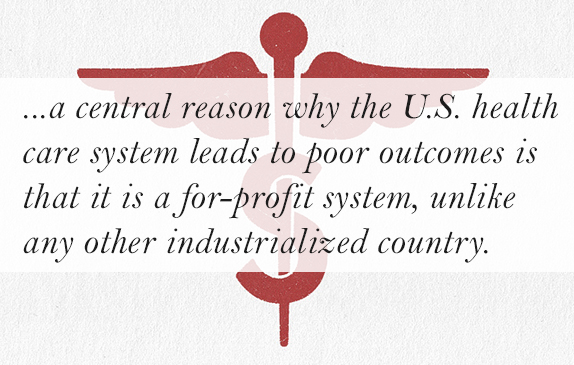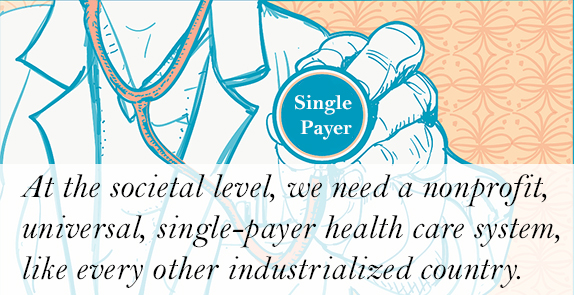As a young adult, I regularly went to doctors for checkups and illnesses and followed their advice scrupulously, without ever questioning it. However, by my late thirties I began to realize that much of the medical advice given to me and my family members appeared misguided, and that prescribed treatments sometimes exacerbated rather than alleviated our health problems. By middle age, most of my own health problems were iatrogenic, or caused by side effects of treatments or medication. I began to question doctor recommendations.
Here are some examples from my own family members’ medical experiences: 1. During a routine colonoscopy when the patient had no symptoms and the colon looked completely normal, the doctor took biopsies, apparently ineptly; the procedure produced pain and bleeding, subsequent problems, and the need for more colonoscopies due to the unnecessary and poorly performed biopsy procedure. 2. A middle-aged woman was advised by her doctor to take a baby aspirin each day due to the fact that her father had had heart disease. A few years later she developed a massive arterial nosebleed that lasted for 12 hours, the first nosebleed that she had ever experienced. She was then advised to stop the aspirin treatment and has had no further problems. 3. A gastroenterologist recommended surgery (sewing the top of the stomach more tightly around the esophagus) on a 16 year old to alleviate symptoms of heartburn. The mother went online to look at the research on this surgery and discovered that it has been found to be ineffective in reducing heartburn. A few years later the mother figured out that the teenager’s heartburn symptoms were actually caused by an allergic reaction to sugarless gum.
As a result of these and other experiences, I became increasingly skeptical about our U.S. health care system and the quality of care it provides. I began to do some research and found substantial objective evidence about the U.S. health care system that increased my skepticism. First, we pay much more for health care than other industrialized countries. In 2012, the U.S. spent $2.8 trillion on health care, which is $8915 per person and 17.2% of our GDP. This is 2.5 times as much as the average of the other industrialized countries.

More importantly, the U.S. has far worse health outcomes than any other industrialized country. Not only do we have lower life expectancy and higher infant mortality, we come in last on virtually every indicator of health across the entire life span. In 2000, the World Health Organization (WHO) ranked the U.S. twenty-fourth in the world in terms of “healthy life expectancy” or the length of life without significant disease or impairment. A 2013 National Research Council study found that even Americans who are white, insured, college-educated and upper-income are less healthy than their counterparts in other advanced countries.
Why is it that we spend so much more and have far worse outcomes than any other industrialized country? One reason that is frequently given is that the U.S. is the only industrialized country without universal health care for citizens. The tens of millions Americans who are uninsured lack access to basic health care, causing (an estimated) tens of thousands of preventable deaths a year. Even insured people are regularly denied access to health care by private insurance companies. Limited access is clearly part of the problem.
However, this rationale assumes that the U.S. health care is a valuable resource and that the only problem is that not everyone has access to it. If this were true, one would expect that only the uninsured would have poor health outcomes, which is not the case. I have become convinced, based both on my own experience and on research I have done, that the problem goes deeper. Our health care system is seriously flawed and frequently misguided, leading to counterproductive treatments, prescription drugs with side effects that are sometimes dangerous, and insufficient emphasis on maintaining health rather than finding and treating disease.
I have become convinced that a central reason why the U.S. health care system leads to poor outcomes is that it is a for-profit system, unlike any other industrialized country. An emphasis on maintaining profits frequently undermines any orientation towards maintaining health. Pharmaceutical companies aim to medicate as many people as possible, irrespective of need or side effects. Doctors are typically paid on a “fee for service” basis, meaning that the more procedures that they perform, the more they earn; this arrangement can lead to overtreatment and unnecessary procedures. Fear of malpractice suits also encourages overtreatment. The profit motive also undermines the quality of care that Americans receive in ways that are often deliberately hidden and frequently not well understood. Fortunately there are several excellent books on the subject, which I summarize below.

Overdosed America by John Abramson, M.D. focuses on the ways in which medical industries, particularly the pharmaceutical industry, subvert the quality of health care by manipulating medical research and knowledge in order to serve corporate interests. Dr. Abramson is a member of the clinical faculty of the Harvard Medical School, where he teaches primary care.
The pharmaceutical industry generates enormous profits, three times the average of other Fortune 500 companies. Dr. Abramson carefully analyzes examples of the ways in which pharmaceutical companies maintain these profits by perpetuating the sale of ineffective and/or unsafe drugs. For instance, Merck withdrew its $2.5 billion a year arthritis drug Vioxx from the market in 2004, citing adverse cardiovascular effects. Many thought that Merck was acting responsibly, giving up a profitable drug in order to protect public health. However, Abramson shows that both Merck and the FDA knew in 2000 that Vioxx was significantly more dangerous and less effective than Aleve because a study revealed that those arthritis patients taking Vioxx had twice as many cardiovascular deaths and four times as many heart attacks as those taking Aleve. For four years American doctors prescribed $7 billion dollars worth of Vioxx, causing an estimated tens of thousands of surplus heart attacks and deaths. I myself knew a woman who took Vioxx for arthritis pain and then died of cardiovascular complications several years later.
How do pharmaceutical companies manage to conceal such evidence from doctors and patients? In the case of Vioxx, the 2000 article (in the prestigious New England Journal of Medicine) that revealed the dangerous cardiovascular side effects of Vioxx (and Celebrex) went on to minimize these statistically significant findings by saying that the number was small and might “reflect the play of chance.” This is a strange statement, since statistical significance tests control for the effects of chance. Abramson reveals that two of the authors of the article had financial ties to the manufacturers of Vioxx and Celebrex. In this case, as well as many others, the researchers, in collusion with the pharmaceutical companies, spin the scientific research so as to suppress negative evidence. Journal articles, even those in the top medical journals, frequently misrepresent the research about new pharmaceuticals. “Marketing masquerading as science” is becoming the norm.
Dr. Abramson goes on to analyze many examples of how medical research is distorted and suppressed, misleading both doctors and patients. For instance, class I antiarrhythmic drugs were discovered to increase the risk of death in 1980 but the research was not published until 1993; an estimated 20,000 to 75,000 lives were lost each year for 13 years as a result—as many as one million unnecessary deaths in all. Another example concerns the drugs used to treat osteoporosis, such as Fosamax; studies show that these drugs are not effective in reducing the risk of fractures, and may actually increase that risk. Finally, Dr. Abramson devotes an entire chapter to hormone replacement therapy, attempting to understand how and why millions of American women were put on these drugs, which substantially increased their risk of cardiovascular disease, Alzheimer’s, and breast cancer; “far more than 100,000 unnecessary cases of breast cancer resulted.”

Eighty per cent of clinical trials are funded by the pharmaceutical and biotechnology industries and 2/3 of research is conducted in for-profit research centers where drug companies “call the shots” and impose “draconian terms” on medical researchers. Methods of distortion and suppression of evidence include: if there are several studies that reach different conclusions about the efficacy and safety of a drug, only the positive results are reported; if negative side effects become apparent in the second half of a study, only results for the first half of a study are reported; in some cases unrepresentative samples are used for drug research, distorting the results. Commercially funded research is four times more likely to favor the sponsor’s product.
Moreover, 80% of the experts who write clinical practice guidelines have financial ties to the pharmaceutical industry. This means that clinical guidelines about such issues as which (if any) women should take hormone replacement therapy, which threshold of hypertension should be used before prescribing medication, and what categories of patients are good candidates for statin drugs to reduce cholesterol levels are all written by groups of experts where the large majority have conflicts of interest.
Dr. Abramson has an entire chapter about the 2001 guidelines on reducing the risk of heart disease, which called for increasing the number of Americans taking statin drugs from 13 million to 36 million. The research on which this recommendation was ostensibly based did not support this recommendation, showing that statin drugs are only effective for men with very high cholesterol and pre-existing heart disease. Dr. Abramson meticulously shows how the research findings were misrepresented so as to justify putting millions of people (women, men without heart disease, the elderly) on these drugs even though the research revealed that such treatment was likely to be ineffective and even dangerous for these groups.
Abramson’s book clearly reveals one of the main reasons why Americans have poor health outcomes: scientific evidence is distorted and adverse drug effects suppressed so that ineffective and sometimes dangerous drugs can be marketed to doctors and patients, ensuring high profits for the pharmaceutical industry. Beginning in 1990’s, prescription drug advertisements and commercials became prevalent, creating even larger markets for the newest and most expensive drugs (which are also the drugs for which side effects are not well researched) and also giving the impression that health and happiness can only be achieved from taking prescription drugs.
The reality is that in most cases diet and lifestyle changes are more effective in preventing disease and keeping people healthy than medication, but such changes are not profitable and are also seen as undesirable for many patients, so they are not emphasized. For instance, diet is twice as effective as statin therapy in preventing second heart attacks, and over 80% of heart disease cases are caused by unhealthy lifestyle and diet. A central problem with our for-profit system is that profit is derived from disease, not health, and there is therefore little incentive in our system to keep people healthy.
Another important way in which our for-profit health care system undermines health outcomes is through overdiagnosis and overtreatment. A key figure in this area is Dr. H. Gilbert Welch, Professor of medicine at the Dartmouth Institute for Health Policy and Clinical Practice, whose book Overdiagnosed: Making People Sick in the Pursuit of Health as well as articles such as this one in the New York Times have helped to raise public consciousness about the dangers of overdiagnosis and overtreatment. One of the cruel ironies in the U.S. today is that millions of uninsured people suffer from inadequate basic health care, whereas those who are insured, including those on Medicare, often suffer from an excess of screening and unnecessary treatment. Health care is not well correlated with need, leading to system inefficiency and poor health outcomes.
Dr. Welch defines overdiagnosis as “when individuals are diagnosed with conditions that will never cause symptoms or death.” It has become prevalent in recent years due to a paradigm shift towards early diagnosis and screening in the absence of symptoms. In the past, people went to the doctor when they were sick and had symptoms. Currently, those with health insurance are periodically screened for abnormalities and often diagnosed and treated even if they are asymptomatic. According to Welch, this new paradigm leads to frequent overdiagnosis, which leads to overtreatment and adverse health outcomes, although it also leads to greater profits for doctors, hospitals, screening facilities, and pharmaceutical companies. More and more, we are told that the best way to stay healthy is to be screened regularly, find abnormalities, and treat them early. The more that we are screened and scanned, the more abnormalities that are found in us. Welch cites a recent study of over 1,000 people without symptoms who received a full-body CT scan; 86% had at least one abnormality. The question is, which abnormalities should be treated and which ignored?
Whether a medical abnormality becomes labeled as a disease frequently depends on a numerical threshold. Elevated blood sugar becomes diabetes if it is above a certain number, cholesterol levels above a certain level cause medication to be recommended, etc. In the past few decades, these numerical thresholds have been changed repeatedly, consistently in the direction of expanding the number of people diagnosed with a disease that should be treated. For instance, in 1997 the threshold for diabetes was lowered from a fasting blood sugar level of 140 to one of 126. This change turned 1.6 million people into diabetics. Similarly, in 1997 the hypertension threshold for medication was lowered from 160/100 to 140/90, creating 13 million new candidates for anti-hypertensive medication. In 1998, the threshold for high cholesterol was lowered from 240 to 200, creating 42 million new cases of high cholesterol. In 2003, the threshold for a diagnosis of osteoporosis was changed from -2.5 to -2.0, expanding the number of women with this diagnosis by 6.7 million. The trend in U.S. medicine is clearly to label and treat more and more abnormalities, turning more and more people into patients.
These numerical thresholds are set by expert panels of physicians who frequently have conflicts of interest. For instance, Welch reveals that nine of the eleven doctors who drafted the new hypertension guidelines had financial ties to drug companies making anti-hypertensive drugs. Eight of the nine experts who lowered the cholesterol threshold were paid consultants to the drug companies that make cholesterol drugs. Such conflicts of interest are endemic. Whether the recent threshold changes are good for patients is debatable. However, the changes have certainly been good for the “medical-industrial complex” and pharmaceutical companies in particular.
The expansion of high-resolution medical imaging is another way in which more abnormalities are discovered, labeled, and sometimes treated. We are scanning more than ever, and the resolution of these scans increases every year. In 1980, about 3 million patients had CT scans; by 2006, 62 million people had at least one. Many asymptomatic people have abnormalities that are revealed by this widespread imaging. For instance, 40% of people without knee pain have damaged knee cartilage when scanned by MRI. Over 50% of people without back pain are revealed to have bulging lumbar discs when scanned by MRI. Over 10% of healthy, asymptomatic individuals are revealed by MRI’s to have had a stroke. To diagnose based on imaging alone is clearly unwise, given the danger of overdiagnosis of innocuous abnormalities.
Dr. Welch devotes an entire chapter to mammography. Breast cancer is diagnosed in 250,000 women a year in the U.S. and kills about 40,000 women. How beneficial is mammography screening (in patients without symptoms) in reducing the risk of dying from breast cancer? The benefits vary according to age. At age 40, 2000 women have to be screened every year for 10 years in order for one breast cancer death to be prevented. At age 70, 2.3 cancer deaths are prevented for every 1000 women screened for ten years. Overall, one cancer death is avoided for every 1000 women who are screened for 10 years.
Thus, the overall benefit of mammography is small and most women will not benefit from it. But what is the harm? Some mammograms yield false-positive results with resulting anxiety, unnecessary second mammograms, biopsies, etc. Other mammograms reveal very small, slow-growing cancers that would not cause symptoms for many years; catching them early causes women to become cancer patients earlier but with no positive effect on mortality.
The greatest harm from mammograms is the danger of overdiagnosis of women whose small breast tumors would never cause symptoms. Research has shown that as many as 40% of women who get breast cancer never develop symptoms and die of something else; there is even evidence that some small breast tumors regress and disappear without treatment. Mammography is certainly increasing the number of breast cancer diagnoses, but also the number of overdiagnoses and overtreatments for cancers that would never cause problems. Dr. Welch concludes based on the evidence that for every breast cancer death that is prevented, somewhere between 2 and 10 women are overdiagnosed and treated with no real benefit. He also has a chapter on prostate cancer screening, where overdiagnosis is even more prevalent; his estimate is that for every prostate cancer death that is avoided, between 30 and 100 men are overdiagnosed and treated unnecessarily.

Why is overdiagnosis problematic? What does it matter if you are put on blood pressure medication or cholesterol-lowering drugs sooner than you would have been twenty years ago? The main reason is that medication and treatment typically have side effects—sometimes side effects that are worse than the disease. Blood pressure can be lowered too far if the readings are borderline, resulting in fainting, falls, and broken bones. (I myself fainted, fell, and permanently damaged my knee as a result of overmedication for mild hypertension). No one wants to have a mastectomy unnecessarily, although thousands of women apparently do each year. Prostate cancer surgery can cause impotence and incontinence. X-rays and CT scans expose the patient to surplus radiation, which can cause cancer.
What is to be done? At the societal level, we need a nonprofit, universal, single-payer health care system, like every other industrialized country. The ACA (“Obamacare”) expands access and mandates some reforms, but does not address the problems associated with a for-profit health care system. Medicare for all would be a huge step in the right direction, but even this change would not eliminate the problem of overdiagnosis in and of itself.
We also need to study the health care systems of the other industrialized countries, all of which have better health outcomes than the U.S. A very useful survey and comparative analysis of the health care systems of France, Germany, Japan, the UK, and Canada is The Healing of America: A Global Quest for Better, Cheaper, and Fairer Health Care by T.R. Reid. Reid is a correspondent for The Washington Post and former chief of its Tokyo and London bureaus, as well as a commentator for National Public Radio. He writes engagingly of his travels to these countries, where he sought treatment for a painful shoulder injury in each country. Reid’s discussion of the different health care systems is both fascinating and instructive, as each country has developed thoughtful and innovative approaches from which the U.S. could learn. For instance, some countries have found alternatives to the “fee for service” model of paying doctors, alternatives that provide incentives for doctors to keep their patients healthy rather than rewarding them for overtreatment.
For those of us who are trying to stay healthy in a system that frequently seems to encourage disease, I recommend taking responsibility for one’s own health care decision making. Find doctors who will collaborate with you, do the research on the medical conditions you have, and make your own medical decisions. Eat well, exercise frequently, and take appropriate dietary supplements. For nutritional and lifestyle guidance, I recommend Dr. Andrew Weil’s books, especially Healthy Aging. By making intelligent lifestyle decisions and using medical care in an informed way, we can maximize our chances of living a long and healthy life. In addition, we must work collectively to transform our corrupt medical-industrial complex so that it no longer sacrifices public health on the altar of corporate profits.
(Photos: Money pill by Bill Brooks, textured flag by Beverly & Pack, Caduceus and dollar sign by Colin Dunn, pills by Erich Ferdinand, Dr. and stethoscope illustration by opensource.com)




Responses to “America’s For-Profit Health Care Dilemma”